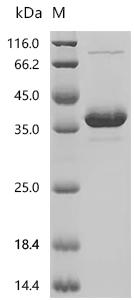This recombinant mouse Resistin comes from a mammalian cell system, which appears to ensure proper folding and post-translational modification. The protein includes the full length of the mature sequence from amino acids 21 to 114. It's tagged with an N-terminal hFc1 for enhanced stability and detection. SDS-PAGE verification shows purity exceeding 95%, making this a reliable reagent for research applications where high-quality protein is essential.
Resistin is a hormone that's primarily involved in metabolic processes. It notably influences glucose metabolism and insulin resistance. This protein belongs to the adipokine family and has been studied extensively for its role in obesity-related research. Resistin likely serves as a key component in regulating inflammation, which may provide valuable insights into metabolic syndrome and cardiovascular research. This makes it an important target for understanding complex metabolic pathways.
Potential Applications
Note: The applications listed below are based on what we know about this protein's biological functions, published research, and experience from experts in the field. However, we haven't fully tested all of these applications ourselves yet. We'd recommend running some preliminary tests first to make sure they work for your specific research goals.
Mammalian cells provide the appropriate environment for proper folding, disulfide bond formation, and post-translational modifications required for resistin's biological activity. Resistin is known to form disulfide-linked multimers and requires correct oligomerization for its function in metabolic regulation. The hFc tag may enhance solubility and purification but could potentially affect the protein's native oligomerization state or receptor binding. While the mammalian expression system suggests a high probability of correct folding, the protein's bioactivity (e.g., receptor binding ability) remains unknown without experimental validation.
1. Antibody Development and Validation Studies
This application is highly suitable. The mammalian-expressed resistin with hFc1 tag is an excellent immunogen for generating specific antibodies. The Fc tag facilitates purification, and the mammalian system likely preserves native conformational epitopes. Validate resulting antibodies against native mouse resistin from physiological sources to ensure recognition of natural oligomeric forms.
2. Protein-Protein Interaction Studies
The hFc1 tag enables protein A/G-based pull-down assays to study interactions with potential receptors or binding partners. However, the Fc tag itself may cause non-specific binding through Fc receptors. Validate any identified interactions using tag-free resistin or confirm with complementary methods like surface plasmon resonance. First, confirm the protein's receptor-binding capability.
3. ELISA Development and Standardization
This recombinant mouse Resistin is suitable for ELISA development, but with important considerations. The hFc1 tag allows oriented immobilization via anti-Fc antibodies, potentially improving assay sensitivity. However, ensure the detection antibodies target resistin-specific epitopes not blocked by the Fc tag. Validate the assay with native resistin standards to ensure accurate quantification of physiological forms.
4. Biochemical Characterization and Stability Studies
This recombinant mouse Resistin is well-suited for biophysical characterization. The high purity enables accurate analysis of oligomerization state (important for resistin function), thermal stability, and structural properties. However, the hFc tag may influence the observed oligomerization behavior - compare with tag-free resistin when possible.
Final Recommendation & Action Plan
Before using this recombinant resistin for functional studies, validate its bioactivity through receptor binding assays or functional cellular assays (e.g., testing its effect on insulin signaling). Confirm its oligomeric state using size exclusion chromatography with multi-angle light scattering. For antibody production, proceed directly, but validate antibodies against native resistin. For interaction studies, consider cleaving the Fc tag if it interferes with physiological interactions. Always include appropriate controls accounting for the Fc tag's potential non-specific binding.






